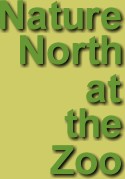
Return to NatureNorth's
Front Page
NatureNorth
at the Zoo |
|

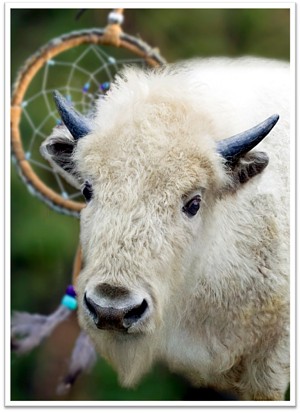 The
Story of Blizzard - The White Buffalo The
Story of Blizzard - The White Buffalo
By Dr. Robert E. Wrigley, Curator, Assiniboine Park Zoo (Please see Update)
As the Curator at the Assiniboine Park Zoo, it is my responsibility to
acquire new animals for our conservation and interpretive programs. In
2006, I was in the process of arranging an exchange of European Bison
with a rancher in the United States, when he informed me that a white
calf had been born in June 2005 in his large herd of Plains Bison. His
animals originated from the herd in Custer State Park, South Dakota. I
immediately expressed interest in acquiring this white calf, since it
would draw many people to the Zoo. The Buffalo is Manitoba’s Provincial
emblem, and historically played a prominent role in the livelihood and
culture of First Nations, Métis, and European traders and settlers.
I thought that Manitobans and visitors would appreciate being able to
see and learn about this rare White Buffalo. While I had heard about Miracle
and Big Medicine – two other famous White Buffalo born on ranches
in Wisconsin and Montana – I must admit I had no idea of the great
spiritual significance of such an animal. I gave the calf his English
name Blizzard not only due to his color, but because he arrived in Winnipeg
during a fierce snow storm on March 6, 2006.
When word of Blizzard’s arrival was made public, a number of First
Nations Elders arrived to inform us of the great importance of this event,
and to ensure that the proper protocol would be followed in showing respect
to such a spiritual animal. Foremost among these advisors was Elder Roger
Armitte, and in the following years he has become a close friend and has
helped me with numerous media interviews and documentaries on Blizzard.
Another individual who showed great interest in our White Buffalo was
Winnipeg Police Service Patrol Sergeant, Cecil Sveinson. He is a spiritual
caregiver and keeper of the two Sweat Lodges near Blizzard’s enclosure
at the Zoo, and is committed to keeping alive First Nations’ ceremonial
traditions.
(Click thumbnail photos below for larger
images.)
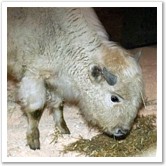 While Blizzard was still in quarantine at the Zoo Hospital, special permission
was granted to Elder Armitte and several other Elders to perform a welcoming
ceremony. This blessing involved a smudge with sweet grass, and singing
a prayer to the beat of a drum. Now most animals are frightened of smoke
and unusual sounds, but Blizzard walked right over to the barn window
and stood reverently for the entire performance, as if he knew that he
was being honored. A second welcoming ceremony and feast, with many more
First Nations attendees, was held after Blizzard was moved to a display
enclosure, and the event was enjoyed as a time of celebration and hope;
Blizzard again remained close by to watch over the activities.
While Blizzard was still in quarantine at the Zoo Hospital, special permission
was granted to Elder Armitte and several other Elders to perform a welcoming
ceremony. This blessing involved a smudge with sweet grass, and singing
a prayer to the beat of a drum. Now most animals are frightened of smoke
and unusual sounds, but Blizzard walked right over to the barn window
and stood reverently for the entire performance, as if he knew that he
was being honored. A second welcoming ceremony and feast, with many more
First Nations attendees, was held after Blizzard was moved to a display
enclosure, and the event was enjoyed as a time of celebration and hope;
Blizzard again remained close by to watch over the activities.
Blizzard has sometimes looked a little strange with mats of shedding
hair hanging from his sides. And like all Bison, he enjoys rolling in
the dust and mud wallows, so we can never guarantee visitors and photographers
that our White Buffalo will always be white. He looks best in his fresh
and clean winter coat, especially after he rolls in the snow. Seeing Blizzard
and a brown female together in a field of snow makes for a fascinating
photograph, and he all but disappears from view on a snowy day.
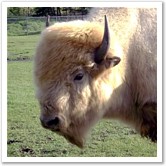 When Blizzard was finally introduced to our Bison herd, the meeting caused
great excitement. I have never heard so much grunting and snorting, and
witnessed such astonishing speed from these huge animals, as the herd
charged back and forth across the field. When placed together a few days
later, there was plenty of head butting and pushing, and I was quite concerned
at times that the jousting was getting out of hand. Heads colliding and
horns pounding into rib cages is not a reassuring sight or sound. Finally
things settled down, and the dominant females eventually accepted his
presence. Perhaps because he looks so different in his white coat, the
females still keep him on the outside of the group. As he matures and
reaches full size, this relationship will change as he takes charge of
the herd. Blizzard still appears to enjoy visiting with people, and of
course the appearance of a pail of alfalfa pellets will bring him at a
gallop over to the fence. I have introduced a number of First Nations
people to Blizzard, and it is touching to see their emotional reactions
at being so close to their spiritual animal. Blizzard always responds
with interest and gentleness, taking bunches of grass from their hands
with his long and soft tongue.
When Blizzard was finally introduced to our Bison herd, the meeting caused
great excitement. I have never heard so much grunting and snorting, and
witnessed such astonishing speed from these huge animals, as the herd
charged back and forth across the field. When placed together a few days
later, there was plenty of head butting and pushing, and I was quite concerned
at times that the jousting was getting out of hand. Heads colliding and
horns pounding into rib cages is not a reassuring sight or sound. Finally
things settled down, and the dominant females eventually accepted his
presence. Perhaps because he looks so different in his white coat, the
females still keep him on the outside of the group. As he matures and
reaches full size, this relationship will change as he takes charge of
the herd. Blizzard still appears to enjoy visiting with people, and of
course the appearance of a pail of alfalfa pellets will bring him at a
gallop over to the fence. I have introduced a number of First Nations
people to Blizzard, and it is touching to see their emotional reactions
at being so close to their spiritual animal. Blizzard always responds
with interest and gentleness, taking bunches of grass from their hands
with his long and soft tongue.
I was privileged, through the kind invitation of my friend Cecil Sveinson,
to witness and participate in a Sweat Lodge Ceremony at the Zoo, and a
Sun Dance Ceremony in the Sacred Sandhills near Carberry, Manitoba. For
a White person, these were experiences I will never forget, and I felt
like I was stepping back into an ancient time to observe the most-sacred
and private of ceremonies of a people little known to my culture. In this
regard, I would like to recount a special story entitled: “The Legend
of the White Buffalo Calf Woman,” which epitomizes beautifully what
this rare animal has meant to the people of the Plains for over a thousand
years. This legend tells how White Buffalo Calf Woman brought the gifts
of knowledge, food, prayer (including Sweat Lodge and Sun Dance ceremonies),
and a sacred pipe to the Lakota Nation, while camped in the sacred Black
Hills of South Dakota, which ironically was Blizzard’s ancestral
home. To this day, a respected woman is given the honor of representing
Buffalo Woman during Sun Dance rituals. Two ancient pipes have survived
to this day, and are kept by the Looking Horse family on the Cheyenne
River Indian Reservation of South Dakota.
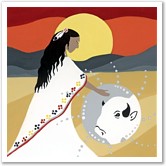 Originally numbering about 60 million head, the Buffalo was the foundation
of the Plains First Nations’ way of life – providing food,
clothing, tools, fuel, and materials for their homes and ceremonies. Before
the coming of White Buffalo Calf Woman, the People of the Plains suffered
from starvation and disease – the consequences of not following
traditional ways. The Lakota bands came together at the Seven Sacred Council
Fires and instructed young scouts to search in all directions for game.
Walking northwest from camp, towards Devil’s Tower, two scouts stopped
to rest on a hill, and spotted a figure in the distance. As it came closer
they saw it was a White Buffalo calf. Suddenly the calf turned into a
beautiful young woman dressed in shining-white buckskin, colorfully decorated
in quills. She told them she was bringing a holy gift from the Buffalo
Nation, and to prepare the way for her. On hearing this news, and with
great excitement, the people in the camp made ready to receive her in
a large Medicine Lodge, supported with 24 poles. Four days later, the
Holy Woman entered, and began to teach the people the Seven Sacred Rites.
She then opened a pouch to reveal a Sacred Pipe and began praying. Filling
the Pipe with red-willow bark tobacco, she lit it with a burning Buffalo
chip. After walking around the lodge in four circles, she passed the Pipe
to the band Elders, saying that the smoke was the breath of the Great
Grandfather Spirit, the bowl represented the unity of the Buffalo and
the Red Man’s flesh and blood, and the wooden stem was all things
that grew on the Earth.
Originally numbering about 60 million head, the Buffalo was the foundation
of the Plains First Nations’ way of life – providing food,
clothing, tools, fuel, and materials for their homes and ceremonies. Before
the coming of White Buffalo Calf Woman, the People of the Plains suffered
from starvation and disease – the consequences of not following
traditional ways. The Lakota bands came together at the Seven Sacred Council
Fires and instructed young scouts to search in all directions for game.
Walking northwest from camp, towards Devil’s Tower, two scouts stopped
to rest on a hill, and spotted a figure in the distance. As it came closer
they saw it was a White Buffalo calf. Suddenly the calf turned into a
beautiful young woman dressed in shining-white buckskin, colorfully decorated
in quills. She told them she was bringing a holy gift from the Buffalo
Nation, and to prepare the way for her. On hearing this news, and with
great excitement, the people in the camp made ready to receive her in
a large Medicine Lodge, supported with 24 poles. Four days later, the
Holy Woman entered, and began to teach the people the Seven Sacred Rites.
She then opened a pouch to reveal a Sacred Pipe and began praying. Filling
the Pipe with red-willow bark tobacco, she lit it with a burning Buffalo
chip. After walking around the lodge in four circles, she passed the Pipe
to the band Elders, saying that the smoke was the breath of the Great
Grandfather Spirit, the bowl represented the unity of the Buffalo and
the Red Man’s flesh and blood, and the wooden stem was all things
that grew on the Earth.
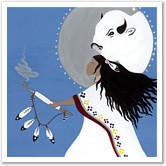 Next
she removed from her bundle, gifts of corn, wild turnip and pemmican.
She showed the women how to cook foods in water in a Buffalo paunch by
dropping in a red-hot stone heated by a hearth fire. She then spoke to
the children -- the precious ones of the next generation -- how someday
they would grow up to have little ones, and to hold the Sacred Pipe and
pray. Before departing, she told the gathering that they were chosen to
keep the Sacred Pipe for all First Nations People on this Turtle Island.
She promised to return someday to renew harmony, prosperity and spirituality.
As she walked away into the setting red sun, she rolled over four times
in the form of a Buffalo, in turn becoming black, brown, red, and finally
a white calf. Soon after, great herds of Buffalo appeared on the grassy
hills, providing the Lakota Nation with all the resources they needed.
Since then, a White Buffalo Calf has become the most-venerated of all
living things.
Next
she removed from her bundle, gifts of corn, wild turnip and pemmican.
She showed the women how to cook foods in water in a Buffalo paunch by
dropping in a red-hot stone heated by a hearth fire. She then spoke to
the children -- the precious ones of the next generation -- how someday
they would grow up to have little ones, and to hold the Sacred Pipe and
pray. Before departing, she told the gathering that they were chosen to
keep the Sacred Pipe for all First Nations People on this Turtle Island.
She promised to return someday to renew harmony, prosperity and spirituality.
As she walked away into the setting red sun, she rolled over four times
in the form of a Buffalo, in turn becoming black, brown, red, and finally
a white calf. Soon after, great herds of Buffalo appeared on the grassy
hills, providing the Lakota Nation with all the resources they needed.
Since then, a White Buffalo Calf has become the most-venerated of all
living things.
With the assistance of the City of Winnipeg Translation Services, and
Aboriginal Languages of Manitoba, I was able to have this Legend translated
into French, Dakota, Cree, Ojibway and Dene, in both Roman orthography
and syllabics. The artwork was created by my daughter-in-law, Bobbie-Joe
Leclair, of First Nations ancestry. These signs demonstrate our appreciation
to First Nations people for the gift of sharing their spiritual beliefs
and traditions with us.
[Download PDF versions of White Buffalo
Calf Woman interpretive signs: Left
Sign (280 Kb) - Right Sign (180
Kb)]
Hundreds of thousands of Zoo visitors come to see Blizzard each year,
and many individuals have developed a close relationship with him, offering
prayers, songs, and gifts of tobacco ties, colored cloth, and dream-catchers.
This calf has become so much more than a display animal -- he is a symbol
of spiritual renewal and hope in our community, and has focused attention
on bringing people of all backgrounds together. It has been a wonderful
experience interacting with numerous individuals from First Nations and
Métis communities, and they have taught me so much about their
traditional relationships with Nature and the spiritual world. I hope
you will have an opportunity to visit Blizzard, and to appreciate what
his presence brings to many people, here in Manitoba and from elsewhere.
More White Buffalo Resources
For more information on white buffalo's here's a good book:
“Seeing the White Buffalo”, by Robert B. Pickering, 1997,
Johnson Books, 160 pp.
An episode of "The Sharing Circle" TV show, Season
15, No. 7, entitled the White
Buffalo Prophecy is available for purchase from the Sharing Circle
Website. Click on their "Order DVD" link.
Photo Credits
Photos in this article are by Darlene Stack, Dr. Robert
Wrigley, Donna Sutherland and Ron Boily.
|